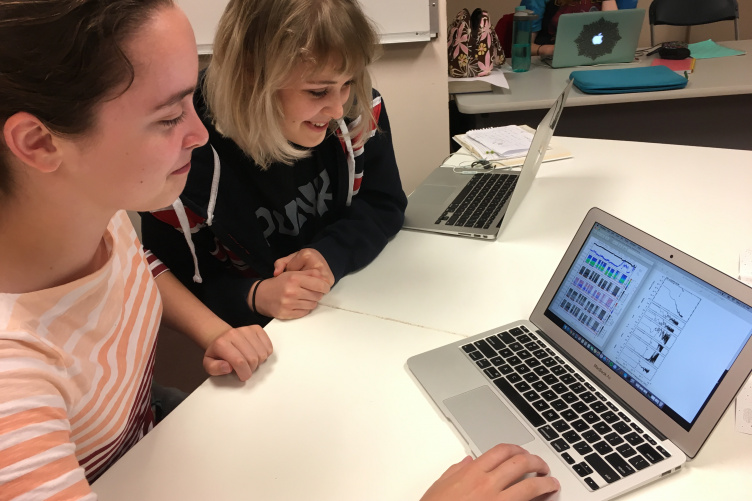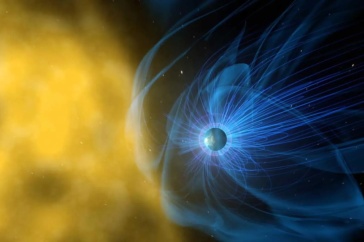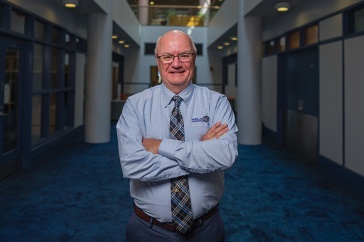
High school students Anastasia Marchuk and Abbey Watson worked with UNH researchers to find data trends in NASA's Ulysses mission.
The edge of space is as close as Morse Hall for high school and college students looking to launch their science careers.
This summer, seven students worked with researchers at UNH’s Space Science Center, conducting impressive space data investigations that, in some cases, have already led to published research even before the students have received their degrees.
“We worked with real data from space, and that is so cool,” says Julia Fitzgibbons ’21, a math major.

Years (or sometimes decades) after a NASA mission is completed, there are scores of data that can be combed through to find new information that will improve our understanding of the solar system and beyond. Fitzgibbons updated a code to conduct statistical analyses of data from NASA’s ACE mission.
“I’ve never coded before, so this was a big challenge,” Fitzgibbons says. “It’s a different mindset than math, and it’s a pretty awesome experience.”
Anastasia Marchuk, who is going into her senior year at Dover High School in Dover, New Hampshire, peered intently at a series of colorful graphs, searching for the wave signatures of specific gases in space. The data was plucked from NASA’s Ulysses mission to study the heliosphere — a mission that UNH researchers were involved in years ago. Marchuk worked with Abbey Watson, a junior at Contoocook Valley Regional High School, in Peterborough, New Hampshire, to pore through previously unexamined data. Marchuk cites her gratitude for the experience and how it will likely have a positive impact on her future.
“This job will help me determine if scientific research is something I really want to do for my career,” Marchuk says.
Most of these students made their way to this research experience after getting involved in UNH’s Project SMART, a four-week program where students build electronics, fly a scientific balloon payload and explore what it means to have a career in science. Researchers at UNH also work closely with local high school science teachers on a program called Space Weather Underground, where students design and build magnetometers to study the magnetic currents in the Earth’s ionosphere. These outreach opportunities have sparked students’ curiosity for space science and have led them to Chuck Smith, UNH research professor of space plasma physics, who oversaw their summertime research projects.
“These are science students and what they learn in their classes is only the beginning,” Smith says. “Here they put it into action and start that transition from reading about it to doing it.”
Sophia Hollock and Zach Pine both attended UNH’s Project SMART in 2015 when they were still in high school and have continued working with Smith each summer since then. Hollock, a sophomore at the Rensselaer Polytechnic Institute in Troy, New York, and Pine, a sophomore at Boston University majoring in physics, have authored five published papers. Most of their current work involves coding to look through NASA’s Voyager data on solar wind.
“Most students don’t get this kind of experience in scientific research,” Pine says. “It’s a big honor to be able to contribute to science in this way.”

Ally Bickford ’22 of Brackney, Pennsylvania, is majoring in physics. This summer she focused on solar wind data from the ACE and WIND missions. Bickford analyzed interplanetary shock waves — where the interplanetary plasma undergoes abrupt changes over very short distances — and the magnetic fluctuations both upstream and downstream of shocks. Shreya Dua, a senior at Concord High School, in Concord, New Hampshire, wrote a code to fit the intensity of magnetic fluctuations upstream of interplanetary shocks. Eventually, the efforts of Bickford and Dua will be combined to better understand particle acceleration at shocks.
Overall, Smith says he is impressed with the level of work these students conducted, as well as their maturity level. “They’ve worked hard, sometimes for a couple of years, to develop a data base of information that has paid off in a big way — finding the physics we were searching for and other results we did not expect to find,” he says. “My hope is that a year from now, each of them will have at least one journal article with their name on it, along with an experience that will help them decide the path their lives will take.”
-
Written By:
Rebecca Irelan | Institute for the Study of Earth, Oceans, and Space | rebecca.irelan@unh.edu | 603-862-0990

















































